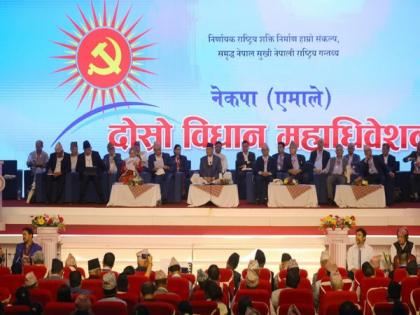Nepal: Oli's UML's policy convention calls India, China to withdraw agreement on Lipulekh
By ANI | Updated: September 8, 2025 00:25 IST2025-09-08T00:24:22+5:302025-09-08T00:25:07+5:30
Lalitpur [Nepal], September 8 : The CPN-UML (Communist Party of Nepal- Unified Marxist Leninist) has expressed serious disagreement with ...

Nepal: Oli's UML's policy convention calls India, China to withdraw agreement on Lipulekh
Lalitpur [Nepal], September 8 : The CPN-UML (Communist Party of Nepal- Unified Marxist Leninist) has expressed serious disagreement with the agreement between India and China to use Nepal's Lipulekh for trade.
Endorsing the special document that concluded on Sunday, the UML has called on both countries to withdraw from the arrangement.
The party has urged the Nepalese government to resolve the issue through high-level diplomatic initiatives and assert Nepal's rights over the region east of the Kali River. This was included in a 28-point contemporary proposal passed by the policy convention.
The proposal highlighted Prime Minister and UML Chair KP Sharma Oli's disagreement over the Lipulekh trade route agreement during his China visit from August 30 to September 3, noting that "this stance elevated Nepal's international standing." It also cited bilateral and multilateral engagements during the trip that enhanced the country's visibility abroad.
India and China have agreed to reopen border trade through Lipulekh Pass, a point located 56 kilometres inside Nepal's western frontier in Limpiyadhura. The agreement was made during Chinese Foreign Minister Wang Yi's visit to India in August.
Both countries made the agreement during a meeting between the Indian External Affairs Minister S. Jaishankar and the Chinese Foreign Minister Wang Yi. Point nine of the joint communique mentions the resumption of border trade. "Both sides agreed to the re-opening of border trade through the three designated trading points, namely Lipulekh Pass, Shipki La Pass and Nathu La Pass."
Nepal's Ministry of Foreign Affairs had objected to the agreement of India and China to open a trade route via Lipulekh, asserting a claim over the land. Issuing a statement, the Ministry asserted claims over the land, objecting to the unilateral move by China and India.
Responding to the release by Nepal's Foreign Ministry, India's Ministry of External Affairs (MEA) rejected Kathmandu's claim and reiterated that trade through the route existed for decades.
The statement released by Randhir Jaiswal, the Spokesperson for the MEA, claimed that the trade had been disrupted in recent years due to COVID and other developments, and both sides had now agreed to resume it.
On Nepal's territorial claims, Jaiswal said such claims were "neither justified nor based on historical facts and evidence," describing them as "untenable."
Earlier in 2020, Nepal amended its constitution, incorporating a new political and administrative map in the preamble of the constitution. The new map included the tri-junction of Limpiyadhura, Kalapani and Lipulekh, which has remained a disputed area between Nepal and India.
Nepal's updated map, prepared incorporating the missing territories, was submitted to the Ministry of Land Management by the Department of Survey, which claims to have taken accurate scale, projection and coordinate system. It was publicly released on 20 May 2020 after a go-ahead signal from the Cabinet meeting on 18th May of the same year.
The department has collected a map drawn during the Treaty of Sugauli, another brought from London, receipts of payment of land revenues and the order issued by the then Prime Minister Chandra Shumsher, as evidence to claim the land belongs to Nepal.
The earlier map issued in 2032 BS had left Gunji, Nabhi and Kuri villages, which have now been included in the recently revised map, adding 335 square kilometres of land.
Tensions had flared between New Delhi and Kathmandu in 2020 after the issuance of a political map by Nepal in mid-May, including the tri-junction, which India had earlier included in its November 2019 map.
Diplomatic ties between the nations severed further after the inauguration of road linking Kailash Mansarovar via Lipulekh on May 8, 2020 after which Nepal handed over diplomatic note to India objecting the move.
Prior to the handover of the diplomatic note, Nepal also had strongly objected to India's unilateral move to construct the road. Nepal said it has "consistently maintained" that as per the Sugauli Treaty (1816), "all the territories east of Kali (Mahakali) river, including Limpiyadhura, Kalapani and Lipu Lekh, belong to Nepal."The Indian Defence Ministry had said the Border Road Organisation (BRO) in Uttarakhand has connected the Kailash Mansarovar route to the Lipulekh pass, which will provide connectivity to border villages and security forces.
India and China discussed the Lipulekh pass for the first time in a decade, following the 2015 visit to China by Indian Prime Minister Narendra Modi. During Modi's visit, then Chinese Premier Li Keqiang agreed to expand trade via Lipulekh. The joint statement issued on May 15, 2015, included the agreement in point 28.
The 2015 decision triggered strong protests in Nepal as the agreement was reached without its consultation, despite the pass lying within Nepali territory. The Nepal government formally objected at the time, sending diplomatic notes to both countries.
With India and China working to improve strained relations following the 2020 Galwan Valley clashes, both sides have once again agreed to open trade through Lipulekh. Nepal's official map includes Lipulekh within its territory.
In 2023, China released a new map showing Lipulekh, Kalapani, and Limpiyadhura as part of India, further complicating the dispute.
Disclaimer: This post has been auto-published from an agency feed without any modifications to the text and has not been reviewed by an editor
Open in app